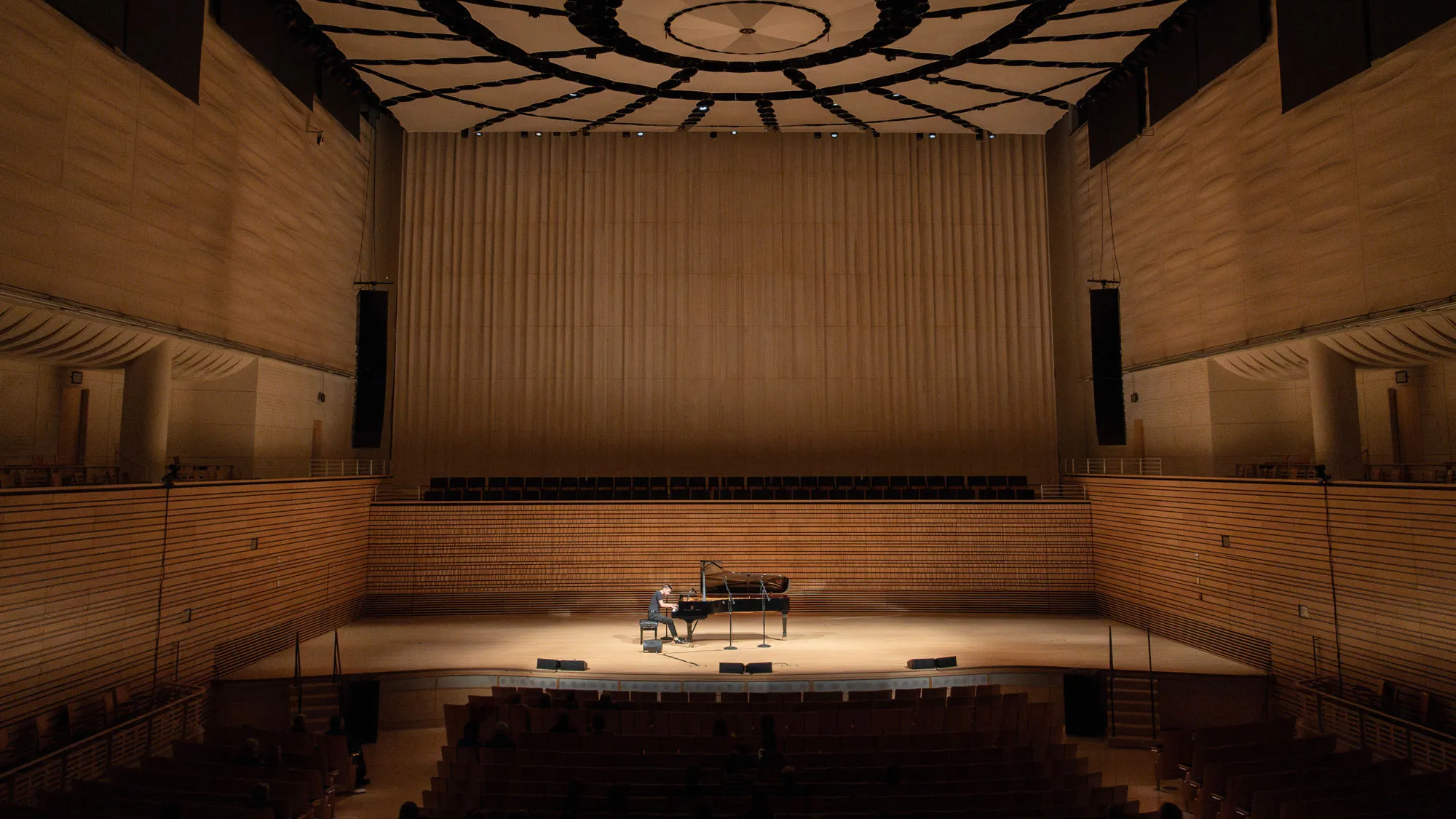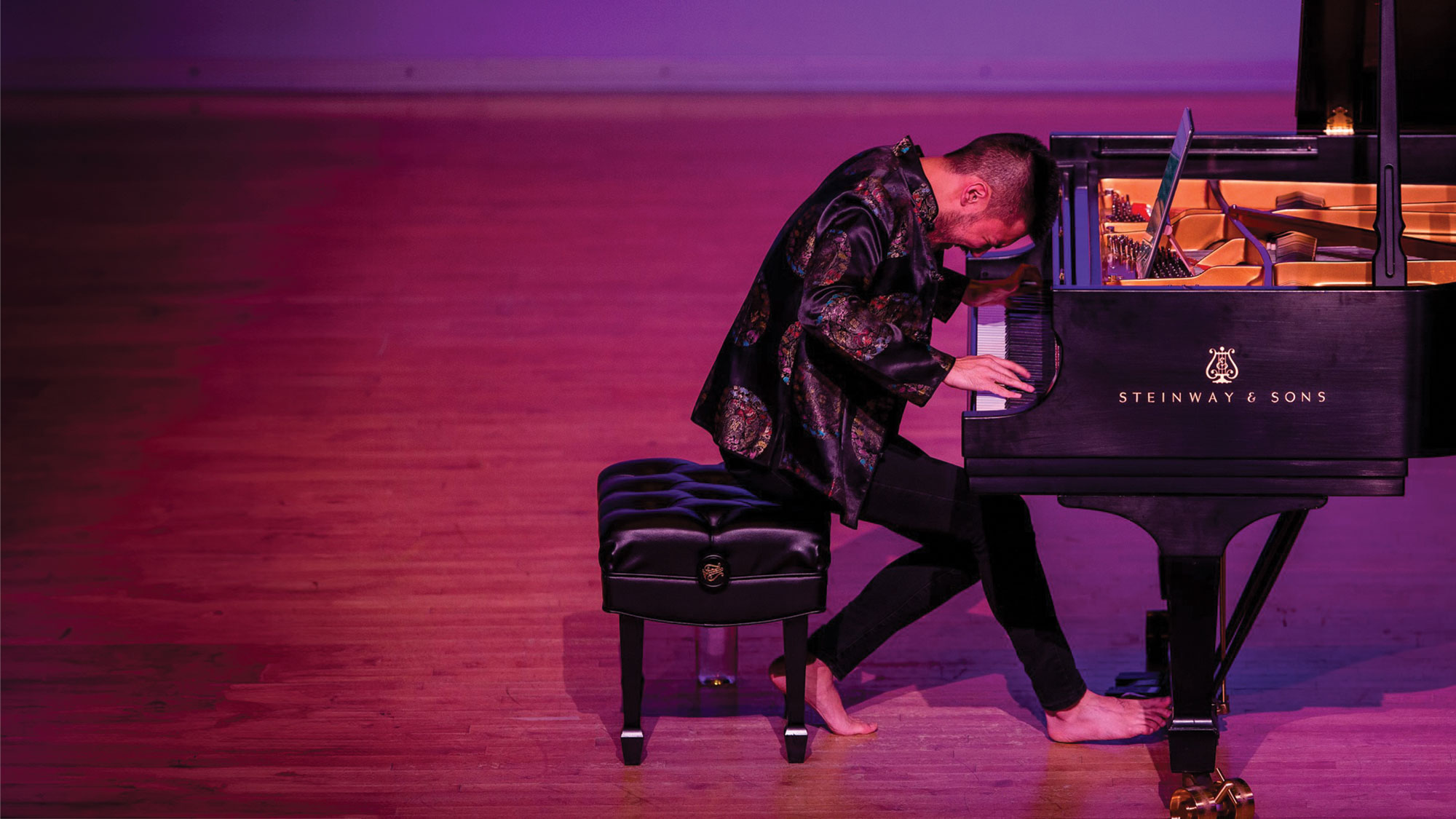
REVIEW: ‘Poetry and Fairy Tale’ — Conrad Tao’s unique solo piano program at EMPAC
Program:
Johannes Brahms, Sechs Klavierstücke op. 118
David Fulmer, I have loved a stream…
Rebecca Saunders, Mirror, mirror on the wall
Todd Moellenberg, Leg of Lamb (after Bernadette Mayer)
Maurice Ravel, Gaspard de la nuit
Conrad Tao is a brilliant triple-threat musician, as pianist, composer, and improvisor. He is also a thoughtful and innovative concert programmer. He has the “chops” to perform challenging concertos (he will be playing Mozart with the New York Philharmonic next month); he has composed on commission from many orchestras including this one; and he has given solo recitals of major repertory in significant venues. All these markers of what is generally considered a successful career, however, are raised to another level by his unique qualities as a creative musical thinker. Attending a performance such as the one offered on a very cold January night at Rensselaer Polytechnic Institute’s Experimental Media and Performing Arts Center (EMPAC) puts this uniqueness into sharper focus. (It is too bad that more people did not come out to hear this program; of the 1,200-plus seats in EMPAC, only about 85 were filled.)
Tao, like other performers, mixes traditional repertory with new works; however, he does so with a specific trajectory in mind: to weld the disparate parts of a program into a continuous whole that has the shape and flow suggestive of narrative but allowing audience members space to imagine for themselves how it all fits together. The result is a powerfully unified musical experience. In Friday night’s program, entitled “Poetry and Fairy Tales,” this was achieved by using a set of six Brahms pieces, the Klavierstücke op. 118, as a framework within which all the other compositions were embedded. The program opened with the first Brahms piece (Intermezzo 1) followed by David Fulmer’s first movement. After four more of Brahms (Intermezzo 2, Ballade, Intermezzo 3, Romanze) the remainder of the program followed, with the final Brahms (Intermezzo 4) acting as the surprisingly effective closing frame.
The new compositions were diverse, but they all reflected Tao’s interest in color and sonic appeal. The full title of Fulmer’s three-part piece is “I have loved a stream and a shadow (with glitter of sun-raps, Nor with stars stretched, nor looking back from heaven)” taken from Ezra Pound’s poems “Ortus” and “Canto III.” The sweeping grandeur of Brahms’ first piece, whose tempo is marked “molto appassionato,” was amplified by Fulmer, whose first movement offered a brilliant and colorful traversal across the keyboard, emphasizing its extremes: ultra-high-register sparkle and bottom-register thunder. After the dramatic contrasts of the next three Brahms, the simple lyricism of the fourth, “Romanze,” seems to say “once upon a time” with gently rippling trills and runs, leading gently into Saunders’ “Mirror, mirror on the wall,” which evoked magical spells through similar material. These murmurings alternated with soft middle-register tone clusters akin to the ones Charles Ives used in the “Hawthorne” movement of his “Concord” Sonata, also an evocation of otherworldly spirits. Discontinuity provided by periods of silence and unexpected new fragments, including thumps of foot-stamping and rattling of piano pedals, enhanced a timeless, spooky otherworldliness.
Intermission was followed by the most remarkable element of the program, but also the shortest: Todd Moellenburg’s setting of “Leg of Lamb,” a poem about poetry by Bernadette Mayer. For Tao, the poem’s opening points to an issue explored throughout the program, that of continuity/discontinuity: “A line / Break could reflect / The way the sun breaks …” Moellenburg has the pianist read the poem while playing; the score does not specify rhythms, allowing the performer to shape the music to the inflections of their voice. The unique result lies somewhere between spoken melodrama, Sprechstimme (used by Schoenberg in “Pierrot lunaire”), and song, but the effect is different from all of these. The piano music merges with the speaking voice into a unified whole, one that the speaker is in a unique position to control and coordinate. Tao’s reading was eloquently appropriate to the poetry (without the kind of exaggerated declamation found in Schoenberg) and his piano provided a magic aura around the sound of his (amplified) voice. The result was in many ways the most magical moment in the program, in that the poetic implications of earlier works manifested here in the sounds of the human voice fused to its enchanting musical surface. The experience was all too brief, making one wish to hear more of this composer’s work. (Tao later assured me that there were many more such pieces by Moellenberg.)
The remaining two sections of Fulmer’s work contained rich harmonies generating strong overtone spectra that were allowed to float and drone, creating yet more and different otherworldly spaces in preparation for the climactic work of the program. This was Ravel’s “enactment” of three poems by Aloysius Bertrand, “Gaspard de la nuit,” allegedly penned by the Devil himself. Taking the poet at his word, Ravel crafted piano music in the same diabolical spirit, offering the performer unheard-of technical challenges that combine Lisztian super-virtuosity with a symbolist-impressionist color palette and a uniquely dark tragic-comic vision. The poems’ subjects are all magical and demonic: Ondine is the water spirit who draws travelers to their watery deaths; in Le Gibet, the hanged man’s dying sighs fuse with the sounds of insects and the blood-red of the setting sun; and the prankster-dwarf Scarbo appears at a moonlit midnight hour to dance demonically and then vanish. This description of the poetry can serve equally for the remarkable, vivid atmospheres generated by amazingly resourceful use of the piano. The macabre beauty of this music seems under the influence of Baudelaire’s “Fleurs de mal.”
The musical post-script to “Gaspard…,” Brahms’ final Intermezzo in E-flat minor, served to bring the program full-circle. It meshed remarkably (and unexpectedly) with the mysterious ending of “Scarbo.” Brahms’ single-note melody meandering in the upper register, using the final pitches of the Ravel, seemed like a direct continuation of it (see fig. 2), with Scarbo’s vanishing point becoming the site of Brahms’ hesitant re-emergence. We tend to put these two composers in very different categories, but Tao demonstrated that they have surprisingly much in common.
Tao is a complete virtuoso, but saying that can be misleading. There are those pianists who are known for their ability to perform the most physically challenging music with apparent ease, expressiveness, and individual character. Tao can do all of that, but in addition, his playing expresses a total physical, mental, emotional, and spiritual commitment to the music: With him, apparently effortless virtuosity becomes completely expressive. In his notes to “Mirror, mirror,” he discusses the role of beauty and the danger of vanity in connection with the “Snow White” story and his own playing, with the requirement he places on himself “not to cling anxiously to any single aesthetic surface” while at the same time focusing on a love of sound itself. This program was designed to mirror and interweave such ideas across the categories of old and new, German classicism and French impressionism, traditional aesthetics and noise, beauty and terror. Such thinking seems inseparable from Tao’s artistic personality, and it communicated powerfully throughout his committed performance of this ingeniously assembled program.

Main image: Conrad Tao in rehearsal on the concert hall stage. Courtesy the artist. Photo: Michael Valiquette/EMPAC.
